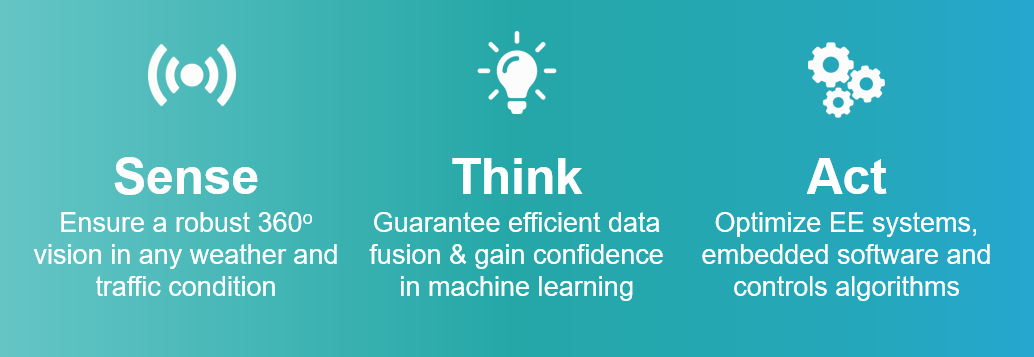Engineering “Sense-Think-Act” for reliable autonomous vehicles

It’s a great time to be an engineer in the automotive industry. Our worldwide economies are significantly evolving, triggered by development in emerging markets, the accelerated pace of new technologies, sustainability policies, and changing consumer preferences around ownership. These definitely reflect on the car industry: electrification, autonomous driving, connectivity, shared mobility. The century is still young, but its disrupting trends are deeply transforming the sector. As a a matter of fact, companies in the supply chain have no choice but to innovate more than ever.
When it comes to autonomous driving, Mc Kinsey says: “once technological and regulatory issues have been resolved, up to 15 percent of new cars sold in 2030 could be fully autonomous”. 15%. 2030. It’s tomorrow. I must admit, I’m not ready. Not later than a month ago, my father drove me to my favorite restaurant (yes he is the best dad ever). At some point, he wanted to show me one of the nice ADAS features of his newly purchased car, the lane centering and adaptive cruise control. So driving at 130 kilometer per hour on the highway, he suddenly puts his hands away of the wheel and started looking at me without any fear. That lasted 20 endless seconds, and I finally could not refrain from taking the wheel back when approaching a curvy tunnel – I was already picturing us going straight away in the wall.

The rise of ADAS has demonstrated that one of the primary challenges impeding faster market penetration are consumer understanding and safety/security issues. I think both are totally intertwined. Reaching level 5 of vehicle autonomy will require massive efforts in guaranteeing safety and reliability. But how does that translate in AV engineering?
Engineering a self-driving car totally shifts development paradigms. More and more liability is transferred from the drivers to the manufacturers, so certification will become drastic. What makes a vehicle autonomous? First, it’s sensing capabilities, enabling a 360 degrees vision of the environment. Then the proper hardware and software to make appropriate decisions based on defined critera, among which security and safety are one of the most important. And finally, the capability to allow actuators to act upon the decisions. And all that without sacrifying usual vehicle performance attributes like comfort, drivability, eco-friendliness and power. But we can definitely see that system-level engineering is critical for safety, and involves the development of advanced sensing-thinking-acting functionalities.
How we ensure that the vision around the vehicle is robust in any condition? How can OEMs make sure that collected data are fused correctly? How to guarantee that the processed information enables to act and guarantee safety? Answering those questions and many other requires a change in development methods, as running physical testing is not an option.

Managing the integration of sensor information and providing the appropriate answer instantly is crucial. Massive validation and verification have to be executed, and this strongly requires the implementation of a comprehensive simulation and testing framework that will make the 14.2 billion kilometers testing possible. That’s where Siemens comes into play. How to design, validate and integrate autonomous functionality-critical hardware and software in commercially-viable autonomous vehicles, and thus accelerate their introduction to market? How to deploy a real-time “digital twin” framework for components design and system integration and validation as a bridge between virtual and physical worlds? How to leverage cross-domain systems engineering & simulation from the early phases of product development to avoid costly changes in much later stages? That rings a bell? As we can’t provide all detailed information in this blog post, you can get more in-depth understanding of what we propose by watching this presentation on “Accelerate functionality-critical hardware and software development for autonomous vehicles” given by Puneet Sinha, our AV industry expert, or by attending one of the event we’ll be participating. Any question, feel free to start the discuss in the comments section.


